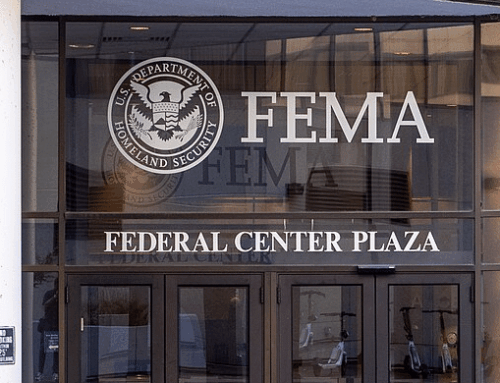November 20, 2025
FEMA Reforms Can Protect American Taxpayers
Dear Member of Congress,
Taxpayers for Common Sense Action (TCS Action) appreciates the bipartisan effort to reform how the federal government prepares for and responds to disasters reflected in H.R. 4669, the Fixing Emergency Management for Americans (FEMA) Act of 2025. With disaster costs spiraling and supplemental appropriations becoming the norm, Congress must act now. With nearly 30 billion-dollar extreme weather events in 2024, taxpayer funds must be directed where they can have the greatest impact. This is the moment to put in place reforms that strengthen FEMA, reduce fiscal exposure, and ensure disaster dollars deliver real value to communities.
The broad bipartisan vote to pass the FEMA Act out of the Transportation and Infrastructure Committee represents real progress. Elevating FEMA to a cabinet-level agency reverses a two-decade-old mistake and recognizes the scale of today’s disaster challenge. Creating a universal application for individual assistance will make it easier for survivors to access aid. Expanding assistance for mitigation and incentivizing states to make their own investments will better protect communities while decreasing future costs. And improving transparency, including through a new public assistance dashboard and GAO/IG reviews, will help ensure federal resources are directed where they are most needed and making a real impact. These are important steps to modernize FEMA and address some of the persistent delays and cost overruns that have undermined recovery.
However, there are ways the bill should be improved going forward. TCS Action provides the following recommendations to improve the FEMA Act and to reform disaster response more broadly—particularly relating to the unique fiscal and safety risks posed by wildfire and the National Flood Insurance Program’s long-standing solvency and affordability problems.
Investing in Mitigation and Reducing Long-Term Costs
The FEMA Act takes steps to expand federal and nonfederal investments in mitigation, but unless dollars are tied to smarter planning and faster deployment, taxpayers will still be on the hook for repeat disasters. To further encourage investments in mitigation, Congress should:
- Require land-use planning reforms: Federal funds should not subsidize new development in high-risk areas. Eligibility for mitigation support and for the increased federal cost-share under the new Section 409 Public Assistance program should require risk-informed zoning and land-use planning at the community scale.
- Set deployment deadlines: FEMA should be required to disburse mitigation funds within fixed timelines, so dollars reach communities before the next disaster, not years after. While the FEMA Act requires states to distribute Section 203 Pre-Disaster Hazard Mitigation funds to local governments within 60 days, there is no set timeline for FEMA to distribute funds to the state. Congress should implement a set timeline for determining annual state formula allocations and disbursing available funds.
- Mandate resilient rebuilding: Federal recovery aid should only support rebuilding to current hazard-resistant standards. The FEMA Act takes important steps in the new Section 409 program by incorporating costs of implementing mitigation measures and rebuilding to applicable building codes. Policymakers should further support resilient rebuilding by explicitly requiring recipients to undertake mitigation measures in funded projects and report on the status of these activities in progress reports.
- Direct mitigation funding where it is most needed: TCS Action supports regular allocations of mitigation funding under Section 203 so states can better plan and budget for mitigation activities. However, policymakers must reevaluate proposed formula allocations—allocating 40 percent of available funds equally among each eligible State, regardless of need, may keep funding from projects with a higher return for taxpayers and communities.
Improving Public Assistance and Cost-Sharing
The FEMA Act modernizes FEMA’s Public Assistance program, including the transition from a reimbursement-based model to a grant-based model, but stronger accountability is needed to ensure states share responsibility and federal dollars are used efficiently. Congress should strengthen the bill by:
- Mandating independent audits of procurement compliance: Standardized procurement rules are important, but without independent audits and public disclosure of violations, taxpayers cannot be sure funds are being spent fairly and efficiently.
- Tying block grants to risk-reduction benchmarks: If states opt for block grants to manage smaller disasters, FEMA should require performance measures—such as updated building codes or defensible space standards in wildfire-prone areas—to make sure federal funds build resilience rather than just cover cleanup costs.
- Requiring reasonable means-testing: Means-testing and payment limits are important tools to ensure federal resources flow to where they are most needed. Policymakers should not prohibit the use of an income threshold in determining eligibility for a duplicative assistance waiver and should consider opportunities to implement reasonable, means-testing provisions, including in the Section 408 and 409 programs.
- Publishing data on public assistance denials: As part of the Public Assistance Dashboard, FEMA should release aggregate data on who is denied aid and why, including geographic information and whether the applicant is a public or private nonprofit facility. Public reporting will improve accountability and help ensure assistance reaches those most in need.
Streamlining Individual Assistance
The FEMA Act simplifies applications for survivors, but it stops short of fixing the fragmented system that forces people to navigate multiple federal programs. To improve both efficiency and fairness, Congress should:
- Require cross-agency determination letters: A universal FEMA application should result in a single determination letter that spans FEMA, SBA, HUD, USDA, and Labor programs, cutting duplication and confusion.
- Publish data on individual assistance denials: The bill takes important steps by creating an Individual Assistance Dashboard and requiring FEMA to publish a ranked list of the reasons for denial. FEMA should include geographic and socioeconomic data in its reporting on application denials.
Increasing Transparency and Accountability
The FEMA Act takes welcome steps on transparency, including a publicly accessible website tracking disaster assistance at the project level, but still focuses largely on dollars obligated rather than results delivered. Taxpayers need to know whether federal spending reduces risk, not just whether funds are spent. To add more value, Congress should require FEMA to:
- Report outcome-based metrics: Dashboards should include clear data on risks reduced and dollars saved, not just obligations and disbursements.
- Track and publish hazard-specific spending: While project-level and disaster-level data are essential, FEMA should also publish detailed accounts of cross-agency spending by hazard or disaster type—wildfire, hurricane, flooding, tornado, etc.—with crosscuts showing mitigation, response, and recovery.
- Set workforce performance benchmarks: Studies and retention initiatives are useful, but Congress should set measurable goals for deployable staff levels so FEMA can prove it has the workforce to meet concurrent disasters.
- Ensure fair access to mitigation funds to reduce long-term federal costs: Communities with fewer resources often face the highest risks and the hardest time accessing mitigation funds. If they are left out now, taxpayers will face higher federal liabilities later. The Individual Assistance and Public Assistance Dashboards and mandated reports are a crucial step in tracking access across vulnerable communities. Policymakers should seek additional opportunities to make sure risk-reduction dollars reach the places that would otherwise drive repeat costs, particularly in the Public Assistance program and the block grant alternative.
- Encourage states and local communities to make their own investments: The bill takes positive steps by encouraging nonfederal investments in mitigation as a condition for decreased cost-share requirements under Section 409. Congress should consider additional ways to support state and local mitigation efforts, including workforce capacity-building and technical assistance.
- Ensure transparent application of federal cost-share reductions, mitigation formula allocations, and duplicative assistance waivers: Determinations under Sections 203, 312, and 409 must be clearly explained and made publicly available in a timely manner to ensure equitable application.
Additional Actions Congress Should Take to Improve Disaster Response
Outside of the much-needed reforms proposed in the FEMA Act, there are additional steps policymakers should take to improve federal disaster response—particularly concerning federal wildfire spending and the National Flood Insurance Program (NFIP). While we recognize some of these recommendations may fall outside of the Transportation and Infrastructure Committee’s jurisdiction for the original legislation, Congress should seize this opportunity to advance broader, bipartisan reforms that protect both policyholders and taxpayers, including:
- Prioritizing targeted education and outreach: FEMA should take further steps to ensure disaster survivors are aware of available assistance and how to apply, particularly in rural communities.
- Requiring public closeout reporting: FEMA should publish annual, plain-language progress reports on disaster closeouts so taxpayers can track whether backlogs are truly shrinking and how much money is being freed up.
- Prohibiting subsidies for the riskiest new developments: NFIP and other federal disaster programs outside of FEMA must not encourage development in the highest-risk flood and fire zones.
- Expanding support for safer rebuilding: NFIP and other federal disaster programs outside of FEMA should encourage nonfederal risk mitigation investments by offering expanded support. For example, raising the amount NFIP pays when homeowners are required or choose to rebuild to stronger codes would make it possible for more families to rebuild to safer standards, reducing future taxpayer liabilities.
- Coordinating FEMA funding with land management agencies: FEMA should work with the U.S. Forest Service and Department of the Interior to align risk reduction and recovery activities across land management agencies. Without coordination, FEMA dollars risk undercutting long-term resilience by funding short-term fixes.
- Improving mapping and future risk communication: FEMA and other disaster agencies should integrate forward-looking climate projections into disaster programs—including regulatory and non-regulatory flood risk products under the NFIP—to ensure communities and taxpayers aren’t blindsided by future hazards.
- Accurately pricing disasters and creating targeted affordability programs: Federal disaster programs must not hide the true cost of disasters. Instead of artificially lowering rates for everyone, federal programs should ensure recipients (not federal taxpayers) know and pay for high-risk behaviors—including by shifting the NFIP to full-risk pricing through Risk Rating 2.0—while simultaneously adopting means-tested premium assistance for low- and moderate-income households.
Conclusion
The FEMA Act of 2025 is a strong step toward modernizing disaster policy, but important gaps remain. As the bill moves to floor debate and potential amendments, Congress should strengthen the bill with clear requirements for resilient rebuilding, stronger state incentives, and outcome-based metrics so disaster dollars reduce risk instead of repeating past mistakes. It should add targeted provisions for wildfire mitigation, including community-level planning and coordination with land management agencies. And Congress must pair these reforms with long-overdue NFIP solvency and affordability measures to reduce the program’s chronic insolvency.
With mounting federal disaster costs and insurance liabilities rising year after year, the choices made as this legislation progresses will determine whether this reform is remembered as a valiant, but missed opportunity or a turning point toward a more resilient, fiscally responsible system.
We urge swift action on the FEMA Act and FEMA and federal disaster reforms to better protect taxpayers and ensure communities have the resources to mitigate risk and rebuild smarter post-disaster.
Sincerely,
Steve Ellis
President
Download the letter here or scroll down to read below:
- GAO Photo










